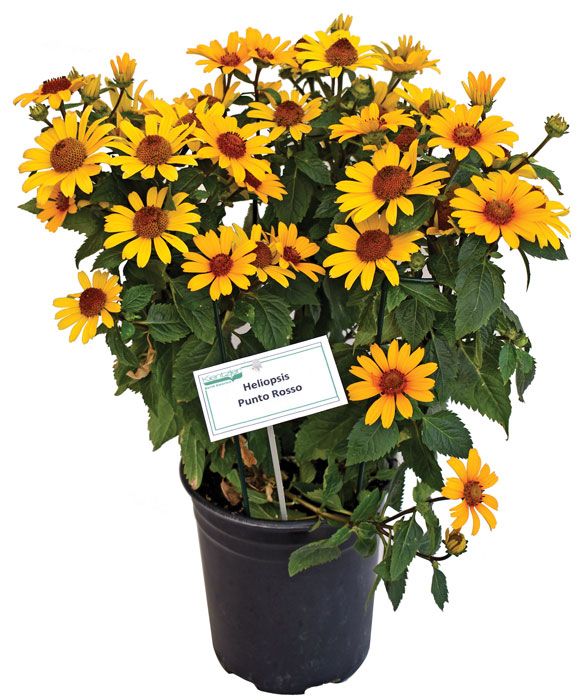6/1/2020
Growing Heliopsis Punto Rosso Compact
Steve Rinehart

Few perennials flower from May to October and are as hardy as heliopsis (Zones 3 to 8). Heliopsis Punto Rosso Compact features bright golden-yellow daisy flowers with continual summer flowering—an easy pick in the garden center if flowering plants are presented.
Perennial re-flowering is so easy with strong hardiness, so why is it so difficult to flower in a container? Keep in mind this long-day plant naturally emerges from the winter weather and surfaces in March, at least in Ohio. Cool nights keep growth checked and flower buds emerge and develop naturally under long-day conditions. Hence, second-year flowering stays compact and full.
Here are some best practices for growing for first-season cultivation:
In-season long-day production scheduling—Typical schedule includes Week 12 sticking as unrooted cutting, Week 16 pinching in propagation, Week 18 transplanting from attached media rooting plug (keeping roots from breaking apart), with target flowering in late June/ July.
Vernalization (not needed)—Holding the plants for an eight-week cooling period at 41F (5C) in winter will encourage natural basal branching, but will not accelerate flowering.
Accelerated flowering—Use of cyclic lighting (four hours of interrupted night lights) can accelerate bud development and be used to induce earlier spring flowering, and enable movement of early schedules. For March flowering, light from propagation through finished flowering.
Pot size—Grow in a 2.5 qt. to 1 gallon. For show-quality production, plant three per pot; for commercial production, plant one per pot and consider double pinching.
Growing—Use warm spring temperatures to accelerate growth, 60 to 65F (15 to 18C) nights and warming to 75 to 85F (23 to 29C) days.
Use of staking—The natural habit of heliopsis is to experience the terminal shoot falling to one side. This shouldn’t be trimmed, as each node will generate a new stem and flower cluster. The use of plant rings and holding the initial terminal shoots upright will encourage a nice full plant that’s centered in the pot.
PGRs—B-Nine can be effective at 1,500 ppm or use of production in long days and acceleration of bud development can mitigate height.
Pests—Spider mites, thrips and whiteflies can be problems and the crop should be scouted frequently.
Disease—Pythium can be a problem and a preventative program is best. Try to avoid high salts and excessive root loss.
Flowering plants can be held for long periods of time—use cool nights of 55F (12C) to hold plants in the greenhouse. GT
Steve Rinehart is Kientzler North America Manager. He can be reached at srinehart360@gmail.com.